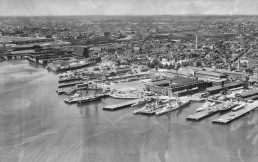
The Navy Yard Plaza in Charlestown, Massachusetts, provides premier office space and a desirable location in the historic Charlestown Navy Yard. Originally part of a four-building historic restoration project comprised of more than 250,000 square feet of office and retail space, Navy Yard Plaza sits within the former Charlestown Navy Yard and is surrounded by public parks and museums.
Buildings 34 & 39 provide updated suites that still retain historic charm. Exposed brick, wooden beams, and high ceilings harmonize artfully with everything needed for today’s office businesses. In addition to stunning views of the harbor and elevator access with key card security, businesses enjoy convenient commuting options with easy access to Routes 1 and 93, ferry boat service to Long Wharf, MBTA Bus Route 93 access, and parking availability at the nearby Building 199.
Navy Yard Plaza was successfully developed by Kenney Development Company, providing responsive ownership and attentive management through its affiliate, Fulton Properties. Tenants in either building can grab coffee at the on-site Dunkin’, walk across the street to a 7-Eleven, enjoy lunch or dinner at the Dovetail Restaurant, or enjoy a beer after work at The Anchor beer garden on the pier.
This historic restoration of Building 39, comprising of office and retail space in the former Charlestown Navy Yard, was completed in 1989. Comprising more than 85,000 square feet, the building received a Preservation Award from the Massachusetts Historic Commission.
A Rich History
The Charlestown Navy Yard was one of six navy yards established between 1799 and 1801 along the east coast of the United States. From 1800 to 1974, its major role was in the construction, repair, and servicing of vessels of the United States Navy. It is also significant as the site of one of the first two naval dry docks in the United States, the location of the Navy’s only ropewalk, and for technical innovations such as die-lock chain.
The Yard As A Manufacturing Establishment: The Ropewalk
One of the most essential manufactured items required by a sailing vessel is rope. The Charlestown Navy Yard had been chosen as the site of a ropewalk intended to supply the needs of the entire Navy for a number of reasons: Boston was one of the leading ports trading in hemp, the raw material for rope; the area had a number of commercial ropewalks from which the necessary skilled workers could be drawn; and the area was a major center of innovation in the textile industry. The Charlestown Ropewalk would be the sole rope manufacturing plant for the Navy for nearly 134 years, supplying most, if not all, of the rope the Navy required well into the 20th century.
The Navy Yard And USS Constitution
One of the first six ships authorized in the Naval Armaments Act of 1794, Constitution was built by Edmund Hartt at his yard in Boston’s North End. As she approached her centennial, she was towed from Portsmouth Navy Yard to the Charlestown Navy Yard. Except for her 1931-1934 cruise around the country, she has been berthed at the yard ever since.
Most of its buildings have been adaptively reused either as historical monuments or commercial and residential facilities. Building 34 completed in 1837, was designed as Store House No. 15 by Alexander Parris and was intended to be a square facility with a central courtyard. In the event, funding for only the north wing was available.
Building 39 is such a unique opportunity for premium office or R & D space in Navy Yard Plaza. Built of brick with granite trimmings, Building 39 was described in 1874 as containing the shops, stores, offices, and armory for the Ordnance Department. In September 1954 the yard began to rehabilitate the First Avenue entrance to the Commandant’s Offices.
Boston National Historical Park
On October 1, 1974, President Gerald Ford signed the Boston National Historical Park Act of 1974. This legislation authorized the establishment of Boston National Historical Park, a unit of the National Park System. The seventh site listed in the park’s legislation was the Charlestown Navy Yard. The act defined the yard “to include the United States Ship Constitution” and approximately 30 acres at the west end and also provided that the National Park Service (NPS) was authorized to enter into written agreements with the Navy to “permit the continued use of any such buildings and facilities as the Secretary of the Interior determines to be necessary.
Of the numerous developers associated with the Navy Yard, one stands out as being of principal im- portance. As director of the Boston Redevelopment Authority from 1971 to 1976, Robert T. Kenney was responsible for the initial BRA plans for the yard. As the head of Kenney Development, he was involved in a number of projects in the Historic Monument Area, notably Navy Yard Plaza (Buildings 33, 34, 38 and 39).
Today, the yard is a thriving mixed-use facility attracting visitors from around the world. Outside of the national park, it has become a residential community, as well as a center for biomedical research.


1 First Avenue
Charlestown, MA
© 2024 Navy Yard Plaza. All rights reserved. Privacy Policy
Website designed by Carlson Communications.

